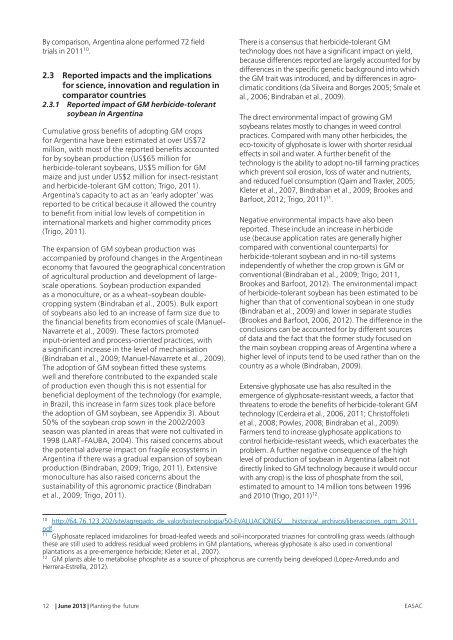Planting the future: opportunities and challenges for using ... - EASAC
Planting the future: opportunities and challenges for using ... - EASAC
Planting the future: opportunities and challenges for using ... - EASAC
You also want an ePaper? Increase the reach of your titles
YUMPU automatically turns print PDFs into web optimized ePapers that Google loves.
By comparison, Argentina alone per<strong>for</strong>med 72 field<br />
trials in 2011 10 .<br />
2.3 Reported impacts <strong>and</strong> <strong>the</strong> implications<br />
<strong>for</strong> science, innovation <strong>and</strong> regulation in<br />
comparator countries<br />
2.3.1 Reported impact of GM herbicide-tolerant<br />
soybean in Argentina<br />
Cumulative gross benefits of adopting GM crops<br />
<strong>for</strong> Argentina have been estimated at over US$72<br />
million, with most of <strong>the</strong> reported benefits accounted<br />
<strong>for</strong> by soybean production (US$65 million <strong>for</strong><br />
herbicide-tolerant soybeans, US$5 million <strong>for</strong> GM<br />
maize <strong>and</strong> just under US$2 million <strong>for</strong> insect-resistant<br />
<strong>and</strong> herbicide-tolerant GM cotton; Trigo, 2011).<br />
Argentina’s capacity to act as an ‘early adopter’ was<br />
reported to be critical because it allowed <strong>the</strong> country<br />
to benefit from initial low levels of competition in<br />
international markets <strong>and</strong> higher commodity prices<br />
(Trigo, 2011).<br />
The expansion of GM soybean production was<br />
accompanied by profound changes in <strong>the</strong> Argentinean<br />
economy that favoured <strong>the</strong> geographical concentration<br />
of agricultural production <strong>and</strong> development of largescale<br />
operations. Soybean production exp<strong>and</strong>ed<br />
as a monoculture, or as a wheat–soybean doublecropping<br />
system (Bindraban et al., 2005). Bulk export<br />
of soybeans also led to an increase of farm size due to<br />
<strong>the</strong> financial benefits from economies of scale (Manuel-<br />
Navarrete et al., 2009). These factors promoted<br />
input-oriented <strong>and</strong> process-oriented practices, with<br />
a significant increase in <strong>the</strong> level of mechanisation<br />
(Bindraban et al., 2009; Manuel-Navarrete et al., 2009).<br />
The adoption of GM soybean fitted <strong>the</strong>se systems<br />
well <strong>and</strong> <strong>the</strong>re<strong>for</strong>e contributed to <strong>the</strong> exp<strong>and</strong>ed scale<br />
of production even though this is not essential <strong>for</strong><br />
beneficial deployment of <strong>the</strong> technology (<strong>for</strong> example,<br />
in Brazil, this increase in farm sizes took place be<strong>for</strong>e<br />
<strong>the</strong> adoption of GM soybean, see Appendix 3). About<br />
50% of <strong>the</strong> soybean crop sown in <strong>the</strong> 2002/2003<br />
season was planted in areas that were not cultivated in<br />
1998 (LART–FAUBA, 2004). This raised concerns about<br />
<strong>the</strong> potential adverse impact on fragile ecosystems in<br />
Argentina if <strong>the</strong>re was a gradual expansion of soybean<br />
production (Bindraban, 2009; Trigo, 2011). Extensive<br />
monoculture has also raised concerns about <strong>the</strong><br />
sustainability of this agronomic practice (Bindraban<br />
et al., 2009; Trigo, 2011).<br />
There is a consensus that herbicide-tolerant GM<br />
technology does not have a significant impact on yield,<br />
because differences reported are largely accounted <strong>for</strong> by<br />
differences in <strong>the</strong> specific genetic background into which<br />
<strong>the</strong> GM trait was introduced, <strong>and</strong> by differences in agroclimatic<br />
conditions (da Silveira <strong>and</strong> Borges 2005; Smale et<br />
al., 2006; Bindraban et al., 2009).<br />
The direct environmental impact of growing GM<br />
soybeans relates mostly to changes in weed control<br />
practices. Compared with many o<strong>the</strong>r herbicides, <strong>the</strong><br />
eco-toxicity of glyphosate is lower with shorter residual<br />
effects in soil <strong>and</strong> water. A fur<strong>the</strong>r benefit of <strong>the</strong><br />
technology is <strong>the</strong> ability to adopt no-till farming practices<br />
which prevent soil erosion, loss of water <strong>and</strong> nutrients,<br />
<strong>and</strong> reduced fuel consumption (Qaim <strong>and</strong> Traxler, 2005;<br />
Kleter et al., 2007, Bindraban et al., 2009; Brookes <strong>and</strong><br />
Barfoot, 2012; Trigo, 2011) 11 .<br />
Negative environmental impacts have also been<br />
reported. These include an increase in herbicide<br />
use (because application rates are generally higher<br />
compared with conventional counterparts) <strong>for</strong><br />
herbicide-tolerant soybean <strong>and</strong> in no-till systems<br />
independently of whe<strong>the</strong>r <strong>the</strong> crop grown is GM or<br />
conventional (Bindraban et al., 2009; Trigo, 2011,<br />
Brookes <strong>and</strong> Barfoot, 2012). The environmental impact<br />
of herbicide-tolerant soybean has been estimated to be<br />
higher than that of conventional soybean in one study<br />
(Bindraban et al., 2009) <strong>and</strong> lower in separate studies<br />
(Brookes <strong>and</strong> Barfoot, 2006, 2012). The difference in <strong>the</strong><br />
conclusions can be accounted <strong>for</strong> by different sources<br />
of data <strong>and</strong> <strong>the</strong> fact that <strong>the</strong> <strong>for</strong>mer study focused on<br />
<strong>the</strong> main soybean cropping areas of Argentina where a<br />
higher level of inputs tend to be used ra<strong>the</strong>r than on <strong>the</strong><br />
country as a whole (Bindraban, 2009).<br />
Extensive glyphosate use has also resulted in <strong>the</strong><br />
emergence of glyphosate-resistant weeds, a factor that<br />
threatens to erode <strong>the</strong> benefits of herbicide-tolerant GM<br />
technology (Cerdeira et al., 2006, 2011; Christoffoleti<br />
et al., 2008; Powles, 2008; Bindraban et al., 2009).<br />
Farmers tend to increase glyphosate applications to<br />
control herbicide-resistant weeds, which exacerbates <strong>the</strong><br />
problem. A fur<strong>the</strong>r negative consequence of <strong>the</strong> high<br />
level of production of soybean in Argentina (albeit not<br />
directly linked to GM technology because it would occur<br />
with any crop) is <strong>the</strong> loss of phosphate from <strong>the</strong> soil,<br />
estimated to amount to 14 million tons between 1996<br />
<strong>and</strong> 2010 (Trigo, 2011) 12 .<br />
10<br />
http://64.76.123.202/site/agregado_de_valor/biotecnologia/50-EVALUACIONES/___historica/_archivos/liberaciones_ogm_2011.<br />
pdf.<br />
11<br />
Glyphosate replaced imidazolines <strong>for</strong> broad-leafed weeds <strong>and</strong> soil-incorporated triazines <strong>for</strong> controlling grass weeds (although<br />
<strong>the</strong>se are still used to address residual weed problems in GM plantations, whereas glyphosate is also used in conventional<br />
plantations as a pre-emergence herbicide; Kleter et al., 2007).<br />
12<br />
GM plants able to metabolise phosphite as a source of phosphorus are currently being developed (López-Arredundo <strong>and</strong><br />
Herrera-Estrella, 2012).<br />
12 | June 2013 | <strong>Planting</strong> <strong>the</strong> <strong>future</strong> <strong>EASAC</strong>


